Surface Area and Volume Exercise 16.2(Part-1) - Class 10 PDF Download
Q.1 Consider a tent cylindrical in shape and surmounted by a conical top having height 16 m and radius as common for all the surfaces constituting the whole portion of the tent which is equal to 24 m. Height of the cylindrical portion of the tent is 11 m. Find the area of Canvas required for the tent.
Solution:
The diameter of the cylinder given in the question is 24m
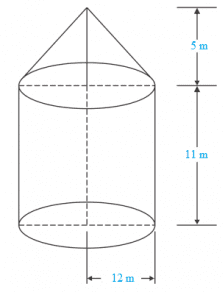
Radius (R) = 12/2 = 12m
The height of the Cylindrical part (H1) given in the question is 11m
So, Height of the cone part (H2) = 5m
Now,
Vertex of the cone above the ground= 11 + 5= 16m
Curved Surface area of the Cone ( say, S1) = πRL = 22/7×6×L
Where,

L= 13m
So,
Curved Surface Area of Cone (S1)
Curved Surface Area of Cylinder (S2) = 2πRH1
S2= 2π(12)(11)m2 ………E.2
To find the area of Canvas required for tent
S = S1 + S2 = E.1 + E.2

S = 490 + 829.38
S = 1319.8 m2
S = 1320 m2
Hence, the total Canvas required for tent (s) = 1320 m2
Q.2 Consider a Rocket. Suppose the rocket is in the form of a Circular Cylinder Closed at the lower end with a Cone of the same radius attached to its top. The Cylindrical portion of the rocket has radius say, 2.5m and the height of that cylindrical portion of the rocket is 21m. The Conical portion of the rocket has a slant height of 8m, then calculate the total surface area of the rocket and also find the volume of the rocket.
Solution:
Given radius of the cylindrical portion of the rocket (say, R) = 2.5m
Given height of the cylindrical portion of the rocket (say, H) = 21m
Given Slant Height of the Conical surface of the rocket (say, L) = 8m
Curved Surface Area of the Cone (say S1) = RL
S1 = m2 ……. E.1
Curved Surface Area of the Cone (say, S2) = 2RH + R2
S2 = (2 π 2.5 21) + (π (2.5)2 )
S2 = (π 105) + (π 6.25) …….. E.2
So, The total curved surface area = E.1 + E.2
S = S1 + S2
S = (π 20) + (π 105) + (π 6.25)
S = 62.83 + 329.86 + 19.63
S = 412.3 m2
Hence, the total Curved Surface Area of the Conical Surface = 412.3 m2
Volume of the conical surface of the rocket 

Let, h be the height of the conical portion in the rocket.
Now,
L2 = R2 + h2
h2 = L2 – R2


h = 23.685 m
Putting the value of h in E.3, we will get
Volume of the conical portion (V1) 
Volume of the Cylindrical Portion (V2) = πR2h

So, the total volume of the rocket = V1 + V2
V = 461.84 m2
Hence, the total volume of the Rocket (V) is 461.84 m2
Q.3 Take a tent structure in vision being cylindrical in shape with height 77 dm and is being surmounted by a cone at the top having height 44 dm. The diameter of the cylinder is 36 m. Find the curved surface area of the tent.
Solution:
As per the question,
- Height of the tent = 77 dm
- Height of a surmounted cone = 44 dm
Height of the Cylindrical Portion = Height of the tent – Height of the surmounted Cone
= 77 – 44
= 33 dm = 3.3 m
Given diameter of the cylinder (d) = 36 m
So, Radius (r) of the cylinder =36/2
R = 18 m
Consider L as the Slant height of the Cone.
L2 = r2 + h2
L2 = 182 + 3.32
L2 = 324 + 10.89
L2 = 334.89
L = 18.3 m
Hence, Slant height of the cone (L) = 18.3 m
The Curved Surface area of the Cylinder (S1) = 2πRh
S1 = 2 π 18 4.4 m2 …………… E.1
The Curved Surface area of the cone (S2) = πRh
S2 = π 18 18.3 m2 ……………. E.2
So, the total curved surface of the tent = S1 + S2
S = S1 + S2
S = (2π 18 4.4) + (π 18 18.3)
S = 1532. 46 m2
Hence, the total Curved Surface Area (S) = 1532.46 m2
Q.4: A toy is in the form of a cone surmounted on a hemisphere. The diameter of the base and the height of the cone are 6 cm and 4 cm, respectively. Determine the surface area of the toy.
Solution:
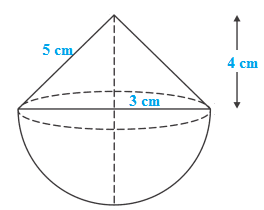
Given that,
The height of the cone (h) = 4cm
Diameter of the cone (d) = 6 cm
So, radius (r) = 3 [as we know that the radius is half of the diameter]
Let, ‘l’ be the slant height of cone. Then,

l = 5cm
So, slant height of the cone (l) = 5 cm
Curved surface area of the cone (S1) =

S1 = 47.1 cm2
Curved surface area of the hemisphere (S2) =

S2 = 56.23 cm2
So, the total surface area (S) = S1 + S2
S = 47.1 + 56.23
S = 103.62 cm2
Therefore, the curved surface area of the toy = S = 103.62 cm2
Q.5: A solid is in the form of a right circular cylinder, with a hemisphere at one end and a cone at the other end. The radius of the common base is 3.5 cm and the height of the cylindrical and conical portions are 10 cm and 6 cm, respectively. Find the total surface area of the solid. 
Solution:
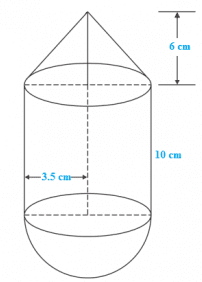
Given that,
Radius of the common base (r) = 3.5 cm
Height of the cylindrical part (h) = 10 cm
Height of the conical part (H) = 6 cm
Let, ‘l’ be the slant height of the cone, then

l = 48.25 cm
Curved surface area of the cone (S1) 

S1 = 76.408 cm2
Curved surface area of the hemisphere (S2) 

S2 = 220 cm2
So, the total surface area (S) = S1 + S2
S = 76.408 + 220
S = 373.408 cm2
Q.6: A toy is in the shape of a right circular cylinder with a hemisphere on one end and a cone on the other. The radius and height of the cylindrical parts are 5cm and 13 cm, respectively. The radii of the hemispherical and conical parts are the same as that of the cylindrical part. Find the surface area of the tor if the total height of the toy is 30 cm.
Solution:
As per the parameters given in the question, we have
Height of the Cylindrical portion = 13 cm
Radius of the Cylindrical portion = 5 cm
Height of the whole solid = 30 cm
Then,
The curved surface area of the Cylinder (say S1) = 2πrh
S1 = 2π( 5 )( 13 )
S1 = 408.2 cm2
The curved surface area of the cone (say S2) = πrL
S2 = π (6) L
For conical part, we have
h = 30 – 13 – 5 = 12 cm
We know that,




L = 13 cm
So, The curved surface area of the cone (say S2) = πrL
S2 = π (5) (13) cm2
S2 = 204.1 cm2
The curved surface area of the hemisphere (say S3) = 2 πr2
S3 = 2 π (5)2
S3 = 157 cm2
The total curved surface area (say S) = S1 + S2 + S3
S = (408.2 + 204.1 + 157)
S = 769.3 cm2
Therefore, the surface area of the toy (S) = 769.3 cm2
Q- 7. Consider a cylindrical tub having radius as 5 cm and its length 9.8 cm. It is full of water. A solid in the form of a right circular cone mounted on a hemisphere is immersed in tub. If the radius of the hemisphere is 3.5 cm and the height of the cone outside the hemisphere is 5 cm. Find the volume of water left in the tub.
Solution:
As per the parameters given in the question, we have
The radius of the Cylindrical tub (r) = 5 cm
Height of the Cylindrical tub (say H) = 9.8 cm
Height of the cone outside the hemisphere (say h) = 5 cm
Radius of the hemisphere = 5 cm
Now,
The volume of the Cylindrical tub (say V1) = πr2 H
V1 = π( 5 )2 9.8
V1 = 770 cm3
The volume of the Hemisphere (say V2) 

V2 = 89.79 cm3
The volume of the Hemisphere (say V3) 

V3 = 64.14 cm3
Therefore, The total volume = Volume of the cone + Volume of the hemisphere = V2 + V3
V = 89.79 + 64.14 cm3 = 154 cm3
Hence, the total volume of the solid = 154 cm3
To find the volume of the water left in the tube, we have to subtract the volume of the hemisphere and the cone from the volume of the cylinder.
Hence, the volume of water left in the tube = V = V1 – V2
V = 770 – 154
V = 616 cm3
Therefore, the volume of water left in the tube is 616 cm3.
Q-8. A circus tent has a cylindrical shape surmounted by a conical roof. The radius of the cylindrical base is 20 cm. The height of the cylindrical and conical portions is 4.2 cm and 2.1 cm. Find the volume of that circus tent.
Solution:
As per the parameters given in the question, we have
Radius of the cylindrical portion (say R) = 20 m
Height of the cylindrical portion (say h1) = 4.2 m
Height of the conical portion (say h2) = 2.1 m
Now,
Volume of the Cylindrical portion (say V1) = πr2 h1
V1 = π (20)2 4.2
V1 = 5280 m3
Volume of the conical part (say V2) 

V2 = 880 m3
Therefore, the total volume of the tent (say V) = volume of the conical portion + volume of the Cylindrical portion
V = V1 + V2
V = 6160 m3
Volume of the tent = V = 6160 m3
Q-9. A petrol tank is a cylinder of base diameter 21 cm and length 18 cm fitted with the conical ends, each of axis 9 cm. Determine the capacity of the tank.
Solution:
As per the parameters given in the question, we have
Base diameter of the Cylinder = 21 cm
Radius (say r) = diameter/2 = 25/2 = 11.5 cm
Height of the Cylindrical portion of the tank (say h1) = 18 cm
Height of the Conical portion of the tank (say h2) = 9 cm
Now,
The volume of the Cylindrical portion (say V1) = πr2 h1
V1 = π (11.5)2 18
V1 = 7474.77 cm3
The volume of the Conical portion (say V2) 

V2 = 1245.795 cm3
Therefore, the total volume of the tank (say V) = volume of the conical portion + volume of the Cylindrical portion
V = V1 + V2
V = 8316 cm3
So, the capacity of the tank = V = 8316 cm3
Q-10: A conical hole is drilled in a circular cylinder of height 12 cm and base radius 5 cm. The height and base radius of the cone are also the same. Find the whole surface and volume of the remaining Cylinder.
Solution:
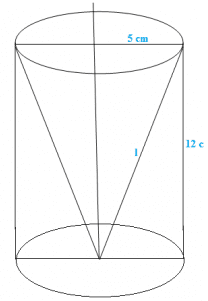
As per the parameters given in the question, we have
Height of the circular Cylinder (say h1) = 12 cm
Base radius of the circular Cylinder (say r) = 5 cm
Height of the conical hole = Height of the circular cylinder, i.e., h1 = h2 = 12 cm
Base radius of the conical hole = Base radius of the circular Cylinder = 5 cm
Let us consider, L as the slant height of the conical hole.


L = 13 cm
Now,
The total surface area of the reamining portion in the circular cylinder (say V1) = πr2 + 2 πrh + πrL
V1 = π( 5 )2 + 2 π( 5)( 12) + π( 5 )( 13 )
V1 = 210 π cm2
Volume of the remaining portion of the circular cylinder = volume pof the cylinder – volume of the conical hole

V = 200 π cm2
Therefore, the volume of the remaining portion of the cylindrical part = V = 200 π cm2
Q-11. A tent is in the form of a cylinder of diameter 20m and height 2.5m surmounted by a cone of equal base and height 7.5m. Find the capacity of tent and the cost of canvas as well at a price of Rs.100 per square meter.
Solution:
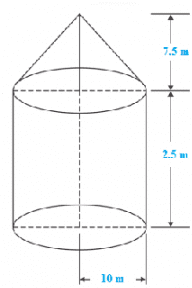
As per the parameters given in the question, we have
Diameter of the cylinder = 20 m
Radius of the cylinder = 10 m
Height of the cylinder (say h1) = 2.5 m
Radius of the cone = Radius of the cylinder (say r) = 15 m
Height of the Cone (say h2) =7.5 m
Let us consider L as the slant height of the Cone, then

L = 12.5 m
Volume of the cylinder = πr2 h1 = V1
V1 = π( 10 )2 2.5
V1 = 250π m3
Volume of the Cone = 

V2 = 250 π m3
Therefore, The total capacity of the tent = volume of the cylinder + volume of the cone = V1 + V2
V = 250 π + 250 π
V = 500 π m3
Hence, the total capacity of the tent = V = 4478.5714 m3
The total area of the canvas required for the tent is S = 2 πrh1 + πrL
S = 2(π)(10)(2.5) + π(10)(12.5)
S = 550 m2
Therefore, the total cost of the canvas is (100) (550) = Rs. 55000
Q- 12. Consider a boiler which is in the form of a cylinder having length 2 m and there’s a hemispherical ends each of having a diameter of 2m. Find the volume of the boiler.
Solution:
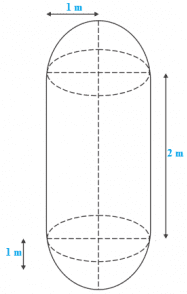
As per the parameters given in the question, we have
Diameter of the hemisphere = 2 m
Radius of the hemisphere (say r) = 1 m
Height of the cylinder (say h1) = 2 m
The volume of the Cylinder = πr2 h1 = V1
V1 = π (1)2 2

Since, at each of the ends of the cylinder, hemispheres are attached.
So,
The volume of two hemispheres 

Therefore, the volume of the boiler = volume of the cylindrical portion + volume of the two hemispheres = V
V = V1 + V2

So, The volume of the boiler 
Q-13. A vessel is a hollow cylinder fitted with a hemispherical bottom of the same base. The depth of the cylinder is 14/3 and the diameter of the hemisphere is 3.5m. Calculate the volume and the internal surface area of the solid.
Solution:
As per the parameters given in the question, we have
Diameter of the hemisphere = 3.5 m
Radius of the hemisphere (say r) = 1.75 m
Height of the cylinder (say h) 
The volume of the Cylinder = πr2 h1 = V1
V1 = π (1.75)2 14/3 m3
The volume of two hemispheres 

Therefore, The total volume of the vessel = volume of the cylinder + volume of the two hemispheres = V
V = V1 + V2
V = 56 m3
Therefore, Volume of the vessel = V = 56 m3
Internal surface area of solid (S) = 2 πr h1 + 2 πr2
S = Surface area of the cylinder + Surface area of the hemisphere

S = 70.51 m3
Hence, the internal surface area of the solid = S = 70.51 m3
Q-14. Consider a solid which is composed of a cylinder with hemispherical ends. If the complete length of the solid is 104 cm and the radius of each of the hemispherical ends is 7 cm. Find the cost of polishing its surface at the rate of Rs. 10 per dm2.
Solution:
As per the parameters given in the question, we have
Radius of the hemispherical end (say r) = 7 cm
Height of the solid = (h + 2r) = 104 cm
The curved surface area of the cylinder (say S) = 2 πr h
S = 2 π ( 7 ) h …….E.1
 )
)
h = 90 cm
Put the value of h in E.1, we will get
S = 2 π (7) (90)
S = 3948.40 cm2
So, the curved surface area of the cylinder = S = 3948.40 cm2
Curved surface area of the two hemisphere (say SA) = 2 (2 πr2)
SA = 22π (7)2
SA = 615.75 cm2
Therefore, the total curved surface area of the solid = Curved surface area of the cylinder + Curved surface area of the two hemisphere = TSA
TSA = S + SA
TSA = 3948.40 + 615.75
TSA = 4571.8cm2 = 45.718 dm2
The cost of polishing the 1 dm2 surface of the solid is Rs. 15
So, the cost of polishing the 45.718 dm2 surface of the solid = 10 45.718 = Rs. 457.18
Hence,
The cost of polishing the whole surface of the solid is Rs. 457.18.
Q-15. A cylindrical vessel of diameter 14 cm and height 42 cm is fixed symmetrically inside a similar vessel of diameter 16cm and height of 42 cm. The total space between the two vessels is filled with Cork dust for heat insulation purposes. Find how many cubic cms of the Cork dust will be required?
Solution:
As per the parameters given in the question, we have
Depth of the cylindrical vessel = Height of the cylindrical vessel = h = 42 cm
Inner diameter of the cylindrical vessel = 14 cm
Inner radius of the cylindrical vessel  ( as we know that the radius is half of the diameter )
( as we know that the radius is half of the diameter )
Outer diameter of the cylindrical vessel = 16 cm
Outer radius of the cylindrical vessel  ( as we know that the radius is half of the diameter )
( as we know that the radius is half of the diameter )
Now,
The volume of the cylindrical vessel 

V = 1980 cm3
Therefore, Volume of the vessel = V = 1980 cm3 = Amount of cork dust required.
Q-16. A cylindrical road roller made of iron is 1 m long. Its internal diameter is 54cm and the thickness of the iron sheet used in making roller is 9 cm. Find the mass of the road roller if 1 cm3 of the iron has 7.8 gm mass.
Solution:
As per the parameters given in the question, we have]
Height of the cylindrical road roller = h = 1 m = 100 cm
Internal Diameter of the cylindrical road roller = 54 cm
Internal radius of the cylindrical road roller = 27 cm = r (as we know that the radius is half of the diameter)
Given the thickness of the road roller (T) = 9 cm
Let us assume that the outer radii of the cylindrical road roller be R.
T = R – r
9 = R – 27
R = 27 + 9
R = 36 cm
Now,
The volume of the iron sheet 

V = 1780.38 cm3
So, the volume of the iron sheet = V = 1780.38 cm3
Mass of 1 cm3 of the iron sheet = 7.8 gm
So, the mass of 1780.38 cm3 of the iron sheet = 1388696.4gm = 1388.7 kg
Hence, the mass of the road roller (m) = 1388.7 kg
Q-17. A vessel in the form of a hollow hemisphere mounted by a hollow cylinder. The diameter of the hemisphere is 14 cm and the total height of the vessel is 13cm. Find the inner surface area of the vessel.
Solution:
As per the parameters given in the question itself, we have
Diameter of the hemisphere = 14 cm
Radius of the hemisphere = 7 cm (as we know that the radius is half of the diameter)
Total height of the vessel = 13 cm = h + r
Now,
Inner surface area of the vessel = 2r (h + r) = SA
SA = 2 (13) (7)
SA = 182 cm2 = 572 cm2
Therefore, the inner surface area of the vessel = SA = 572 cm2
Q-18. A toy is in the form of a cone of radius 3.5 cm mounted on a hemisphere of same radius. The total height of the toy is 15.5 cm. Find the total surface area of the toy.
Solution:
As per the parameters given in the question, we have
Radius of the conical portion of the toy = 3.5 cm = r
Total height of the toy = 15.5 cm = h
Length of the cone = L = 15.5 – 3.5 = 12 cm
Now,
The curved surface area of the cone = πrL = SA
SA = π (3.5) (12)
SA = 131.94 cm2
The curved surface area of the hemisphere = 2πr2 = S
S = 2π ( 3.5 )2
S = 76.96 cm2
Therefore, The total surface area of the toy = Curved surface area of the cone + curved surface area of the hemisphere = TSA
TSA = 131.94 + 76.96
TSA = 208.90 cm2
Hence, the total surface area of the children’s toy = TSA = 209 cm2
Q-19. The difference between outside and inside surface areas of the cylindrical metallic pipe 14 cm long is 44 dm2. If pipe is made of 99 cm2 of metal. Find outer and inner radii of the pipe.
Solution:
Let, inner radius of the pipe be r1.
Radius of outer cylinder be r2.
Length of the cylinder (h) = 14 cm
Difference between the outer and the inner surface area is 44 dm2.
So,
Surface area 

So,
Volume of the metal used is 99 cm2,

Therefore,

Solve E.1 and E.2 to get,


FAQs on Surface Area and Volume Exercise 16.2(Part-1) - Class 10
| 1. What is the formula for calculating the surface area of a rectangular prism? |  |
| 2. How do you find the surface area of a cylinder? |  |
| 3. What is the difference between surface area and volume? |  |
| 4. How can I find the volume of a cone? |  |
| 5. How do you find the surface area of a sphere? |  |


















